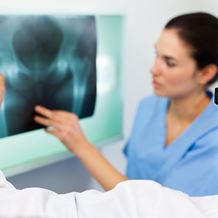Hip Replacement Surgery - Day of Surgery
- Home
- Services
- Orthopaedics
- Knowledge Hub
- Hip Replacement Surgery – Day of Surgery
Hip replacement surgery, also known as arthroplasty, is a common surgical procedure that replaces the damaged hip joint with artificial implants.
The operation is highly effective at reducing pain and improving mobility when non operative treatment is no longer providing the patient with the form, function and quality of life they desire.
A hip replacement is widely regarded as “The Operation of the Century” due to the excellent outcomes. Nonetheless, surgical techniques, implant designs and delivery tools are constantly being refined and improved to enhance this already successful procedure.

Surgical approaches for hip replacement surgery
There are many ways in which a hip replacement can be performed with each case decided on an individual basis. The two most commonly used approaches are the posterior (accessing the joint through the back edge of the femur), and the anterior approach (accessing the joint from the front/ groin). The anterior approach is not suitable for all patients but there is no research to suggest one approach is better than another. As with all surgery there are risks and benefits associated with both methods, and your surgeon will discuss with you which procedure will achieve the optimum results.
Before Surgery
Having observed a 6-8 hour fast, you will be asked to arrive at the hospital in time to complete your clinical admission. Your anaesthetist will explain the type of anaesthetic that will be used and the procedure involved. This is usually a combination of a general anaesthetic, spinal block and local anaesthetic infiltration. Your surgeon will mark the operative site and answer any final questions before the procedure can commence. The operation usually takes round 90 minutes.

During surgery
Incision
Depending on which surgical approach is being used, the surgeon will make a small incision at the side of the hip (posterior) or in the groin (anterior) depending on the agreed approach. This cuts through the skin avoiding any muscle or soft tissue where possible.
Bone removal (Osteotomy)
The hip joint is gently dislocated and the femoral head (the ball at the top of the thigh bone) is removed from the socket so that the diseased parts can be better accessed. The femoral head is then cut off using a specialised bone saw, and the acetabulum (socket of the pelvis) is prepared for the prothesis using a reshaping tool.
Implant attachment
The new acetabular cup is carefully placed into the prepared pelvic socket. Sometimes screws are passed through the socket into the pelvis to assist with fixation. The femur is then hollowed out to accommodate the prosthetic femoral stem which will sit several inches down the femoral canal. The stem and cup can be fixed to the bone with specialised bone cement or a porous surface coating onto which the bone grows providing long term fixation. The ball-shaped femoral head at the top of the stem is accurately designed so that it perfectly fits into the new socket. This is either a metal or ceramic ball which will articulate with a plastic or ceramic liner to facilitate a smooth gliding movement, simulating natural joint activity. The joint is then manipulated to ensure ease of motion, stability and potential impingement, as well as to confirm the correct anatomical configuration such as leg length.
Closing the wound
Any disrupted or damaged muscles and soft tissue are repaired. The wound is sterilised and closed using dissolving sutures so that no stiches are visible or will need to be removed. You are then transferred to the recovery ward.

After Surgery
When you wake up from surgery, a nurse will monitor any post-operative pain through intravenous medication and you will switch over to oral pain relief prior to discharge. Ice packs are helpful in minimising swelling and blood thinners and compression stockings will help reduce the risk of clotting. An X-ray of your new hip will be taken. You will be encouraged to start moving your hip and walking within a day of surgery, with physiotherapy exercises to begin immediately. Most patients spend a 2-5 days in hospital to recover before heading either back home or onwards to rehabilitation. For more information on what to expect after your procedure, see our guide to hip replacement surgery recovery.
What to look out for
- Avoid constipation from pain killers by moving around as quickly as possible after surgery
- Delayed bowel movements are normal for a few days after surgery
- Your IV line won’t be removed until you are successfully up and walking about
- Your physio will give you a full rehabilitation programme of exercises designed to restore strength and mobility
- Adhere to the wound care instructions and look out for any redness around the incision site
- Contact your doctor if you notice any increased swelling that doesn’t improve with rest and elevation

Related Content

Hip Replacement Surgery – Your Recovery
Hip replacement recovery will look different for every patient.
Read More
Hip Replacement
Total hip replacement, or hip arthroplasty, the natural hip joint is replaced with artificial parts.
Read More
Find a Specialist
Talk to our world-leading orthopaedic specialists about the most suitable treatment options.
Read More